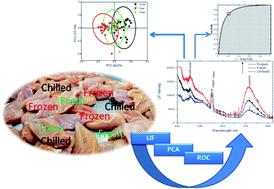当前位置:
X-MOL 学术
›
Anal. Methods
›
论文详情
Our official English website, www.x-mol.net, welcomes your
feedback! (Note: you will need to create a separate account there.)
Discrimination between fresh, chilled, and frozen/thawed chicken based on its skin's spectrochemical and optical properties
Analytical Methods ( IF 2.7 ) Pub Date : 2020-04-01 , DOI: 10.1039/d0ay00324g Omnia Hamdy 1, 2, 3, 4 , Zienab Abdel-Salam 2, 3, 4, 5, 6 , Mohamed Abdel-Harith 2, 3, 4, 5, 6
Analytical Methods ( IF 2.7 ) Pub Date : 2020-04-01 , DOI: 10.1039/d0ay00324g Omnia Hamdy 1, 2, 3, 4 , Zienab Abdel-Salam 2, 3, 4, 5, 6 , Mohamed Abdel-Harith 2, 3, 4, 5, 6
Affiliation

|
Monitoring of the spectrochemical and optical properties of biomaterials has been widely utilized in many biomedical applications for both diagnosis and therapy. Recently, these nondestructive, noninvasive technologies have been used to inspect the quality and safety of food products. In this work, samples from chicken breast skin were investigated spectrochemically and optically to distinguish between fresh, frozen/thawed, and chilled chicken to reveal the adulteration of fresh meat and commercial fraud. Spectrochemical analysis was carried out using the Laser-Induced Fluorescence (LIF) technique. In the LIF setup used, a diode-pumped solid-state laser was used as a pump laser at λ = 266 nm. The LIF spectra were then analyzed statistically using the principal component analysis (PCA) method, while optical analysis was conducted via measurement of the parameters of the absorption and scattering of laser light (λ = 405 nm) on the chicken's skin. The optical absorption and scattering coefficients were acquired using an integrating sphere with a combination of the Beer–Lambert law and the Kubelka–Munk mathematical model. The spatial distribution of light at the sample surface was modeled using Monte-Carlo simulation and finite element solution of the diffusion equation to visualize the results. The potential of the LIF technique combined with principal component analysis in discriminating between the three chicken categories was validated by measuring the optical parameters as well as the simulation model. Besides, the discriminative ability of the proposed method was evaluated using receiver operating characteristic (ROC) curves, which showed sensitivity in discriminating fresh and frozen samples of 0.82 and 0.74 in fresh-chilled separation. These investigations demonstrate the capability of using LIF and proper software for in situ commercial fraud detection, i.e., in supermarkets and/or meat supplier centers.
中文翻译:

根据鸡肉的光谱化学和光学特性区分新鲜,冷藏和冷冻/解冻的鸡肉
生物材料的光谱化学和光学性质的监测已在许多生物医学应用中广泛用于诊断和治疗。最近,这些非破坏性,非侵入性技术已用于检查食品的质量和安全性。在这项工作中,对鸡胸肉的样品进行了光谱和光学分析,以区分新鲜,冷冻/融化和冷藏的鸡肉,以发现新鲜肉类的掺假和商业欺诈。使用激光诱导荧光(LIF)技术进行光谱化学分析。在使用的LIF设置中,二极管泵浦固态激光器用作λ的泵浦激光器= 266 nm。然后使用主成分分析(PCA)方法对LIF光谱进行统计分析,同时通过测量激光的吸收和散射参数(λ= 405 nm)。使用积分球结合了Beer–Lambert定律和Kubelka–Munk数学模型,获得了光吸收和散射系数。使用蒙特卡洛模拟和扩散方程的有限元解对样品表面的光空间分布进行建模,以使结果可视化。通过测量光学参数和仿真模型,验证了将LIF技术与主成分分析相结合以区分三种鸡肉的潜力。此外,使用接收器工作特性曲线(ROC)评估了该方法的判别能力,该曲线显示了在新鲜冷藏分离中区分新鲜和冷冻样品0.82和0.74的灵敏度。现场商业欺诈检测,即在超级市场和/或肉类供应商中心。
更新日期:2020-04-01
中文翻译:

根据鸡肉的光谱化学和光学特性区分新鲜,冷藏和冷冻/解冻的鸡肉
生物材料的光谱化学和光学性质的监测已在许多生物医学应用中广泛用于诊断和治疗。最近,这些非破坏性,非侵入性技术已用于检查食品的质量和安全性。在这项工作中,对鸡胸肉的样品进行了光谱和光学分析,以区分新鲜,冷冻/融化和冷藏的鸡肉,以发现新鲜肉类的掺假和商业欺诈。使用激光诱导荧光(LIF)技术进行光谱化学分析。在使用的LIF设置中,二极管泵浦固态激光器用作λ的泵浦激光器= 266 nm。然后使用主成分分析(PCA)方法对LIF光谱进行统计分析,同时通过测量激光的吸收和散射参数(λ= 405 nm)。使用积分球结合了Beer–Lambert定律和Kubelka–Munk数学模型,获得了光吸收和散射系数。使用蒙特卡洛模拟和扩散方程的有限元解对样品表面的光空间分布进行建模,以使结果可视化。通过测量光学参数和仿真模型,验证了将LIF技术与主成分分析相结合以区分三种鸡肉的潜力。此外,使用接收器工作特性曲线(ROC)评估了该方法的判别能力,该曲线显示了在新鲜冷藏分离中区分新鲜和冷冻样品0.82和0.74的灵敏度。现场商业欺诈检测,即在超级市场和/或肉类供应商中心。











































 京公网安备 11010802027423号
京公网安备 11010802027423号